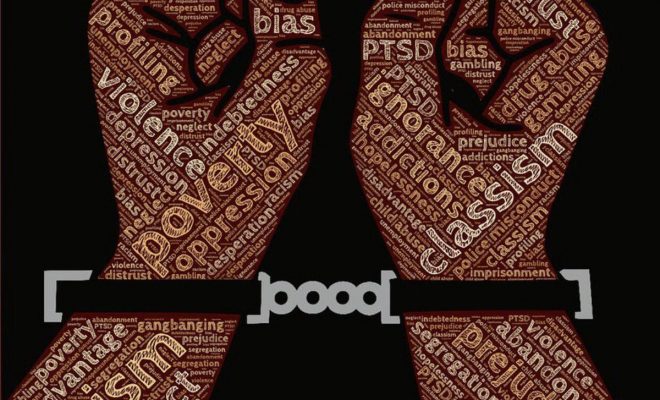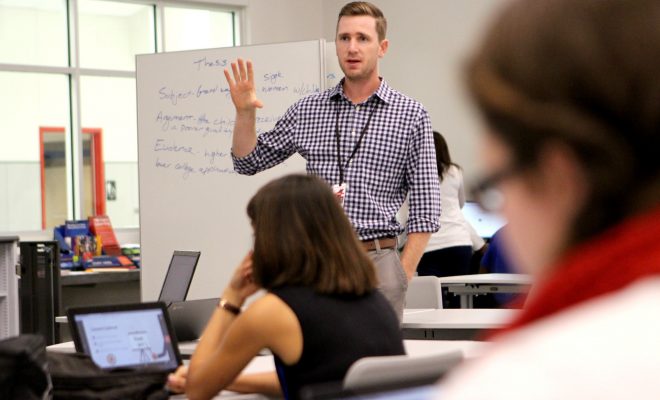Shaping America’s Future: Thoughts on Educating the Hispanic Community in the United States

Hispanics are the fastest-growing minority in the United States. Because they are rapidly making up a significant proportion of our population, it’s important to consider how we as a nation can invest in their success. To do this, we’ll have to look at the specific challenges many Hispanics are experiencing in America, especially when it comes to education. This is just a glimpse of what we can do to achieve education equality for all Americans.
Why it’s important to serve the Hispanic community in the United States
In the 2014-2015 year, minorities were the majority, according to the U.S. Education Department’s Nation Center of Education Statistics. In the fall of 2014, 49.8 million students attended public elementary and secondary schools. And of that 49.8 million students attending public elementary and secondary schools in 2014, White students accounted for just under half at 24.8 million.
Of the remaining 25 million, 12.8 million were Hispanic. And the percentage of White students is predicted to continue decreasing the next several years as enrollments of Hispanics and Asians/Pacific Islanders increase through 2023. This is the last year attendance projections are available.
Around 1.3 million children are expected to attend public prekindergarten in 2014. Public Pre-K enrollment is projected to escalate to about 3.7 million students.
These changing demographics go beyond K-12 education, though
The face of higher education is rapidly evolving as more middle- to lower-class young people find ways to obtain a college degree or technical training. The Hispanic population in the U.S. is no exception as the number of college applicants and enrollees increase every year. While these strides benefit this specific group of students, everyone stands to benefit from Hispanic higher education success.
Take a look at the numbers first
The U.S. Census reports that the estimated Hispanic population in the nation is 52 million – making residents of Hispanic origin the largest minority in the country. In fact, one of every six Americans is a Hispanic. That number is expected to rise to over 132 million by 2050 and Hispanics will then represent 30 percent of the U.S. population. Children with Hispanic roots make up 23 percent of the age 17 and under demographic — making future higher education legislation critical for this growing and thriving minority group.
Young people of Hispanic origin face specific challenges when it comes to higher education. Compared to other demographics, many prospective students are first-generation Americans, or even undocumented residents, and do not have the first-hand experience or guidance from parents regarding the college experience in the U.S. Like all other ethnic groups, Hispanic youth face financial difficulty when trying to determine if college is a possibility. Many young Hispanics may feel overwhelmed by the social and financial pressure associated with college attendance and are in need of the right guidance. While higher education initiatives are changing to address these issues, only 13 percent of the Hispanic population over the age of 25 had a bachelor’s degree or higher in the 2010 Census.
Did the federal government have any solutions?
The Obama administration recognizes the rapid growth of the Hispanic community, specifically as it impacts higher education, and has put several pieces of legislation into motion including the DREAM Act. First introduced in the U.S. Senate in August 2001, the Development, Relief and Education for Alien Minors Act was designed to reward children in good standing that came to the country illegally. Temporary residency is granted for a six-year time frame for young people that seek out higher educational pursuits with an option for permanent residency after completion of a bachelor’s degree or beyond.
The bill went through several iterations before President Obama announced in June 2012 that his administration would stop deporting undocumented immigrants meeting DREAM Act criteria. While this legislation applies to more than Hispanic immigrants, they are the group that stands to benefit the most from its enactment. With no fear of deportation, Hispanic youth with higher education aspirations are free to pursue them and work toward a better individual and collective future.
What’s ahead?
Increasing higher education opportunities for Hispanics has obvious positive benefits for the demographic itself, but the influence will be felt even further. Think of it as a ripple effect, where the Hispanic community represents the initial splash and all other ethnic groups feel the impact too. The Obama Administration has made known its goals to make the U.S. the leader in college degrees earned in proportion to population. In order for this goal to be met, Hispanics (specifically those of Latino descent) will need to earn 3.3 million degrees between now and 2020. The economic success of geographic areas, specifically urban areas, is directly affected by the number of college graduates that study and stay there. In states like Texas, this is an especially poignant point where a one-point college graduate rate increase can result in $1.5 billion more in annual economic activity for cities like San Antonio. Without the help of Hispanic youth, these numbers are difficult, if impossible, to achieve.
Legislation like the DREAM Act is just the start of changing the culture of higher education to be more welcoming to Hispanic youth. Individual colleges and universities must also step up and offer academic and financial aid programs with specific Hispanic needs in mind. The future achievements of higher education in the U.S. are dependent upon the inclusion and success of Hispanic students and the same is true of a stable economic climate. The sooner that federal and state initiatives, along with colleges and universities, embrace these inevitabilities, the better.
That said, although it’s obvious that Hispanics deserve a quality education just like any other American, there are challenges that must be overcome to meet the needs of this population.
Are language barriers the new reason for discrimination?
The practice of placing students in talented and gifted programs is viewed by some as being inherently unfair. After all, who determines what is considered “gifted” in the first place? Some studies have even found that gifted programs favor white students and that Black and Latino students are constantly overlooked. These claims are generally backed up with statistics that show an overwhelming proportion of white students in talented programs and under representation from other demographics.
I’ve written before about the New York Times findings at Public School 163 where one-third of the talented and gifted students are black or Hispanic combined but only 18 percent of the regular student population is white. Teachers there admit that the requirements to enter the program are parent-centric which tends to favor white families in that district. Outright admittance of discrimination is missing from the teacher reasoning, as expected, but the numbers seem to imply it.
But what about districts with obvious discriminatory practices in place? Take Illinois School District U-46, for example. In this particular district, over 40 percent of the student population is Latino but only 2 percent of the gifted program is from this demographic. In July, a federal district court judge found that the school system had discriminated against its gifted Latino students by placing them in a program separate from white peers. The judge also ruled that the policies in place to identify gifted students had a “disparate impact” on the Latino school population. The lawsuit was spearheaded by the Mexican American Legal Defense and Educational Fund.
In this particular case, the Latino students who were placed in separate gifted programs had English as a second language, or were bilingual at least. The language barrier appears to be the excuse used by district leaders for separating Latino students from their white counterparts. Is knowledge of the English language a prerequisite for academic success though? As the world becomes less segmented, particularly when it comes to communication, is it fair to separate our student populations based on their native language?
It all makes me wonder if language has become the new source of segregation. Just as the ruling of Brown vs. The Board of Education found that “separate is… unequal” when it comes to skin color – is the same true of language preferences?
I also wonder how much discrimination is masked by the language excuse. It is taboo to demonstrate the belief that a particular race or ethnicity is inferior but there is often an audience for those who believe English is the superior language. In other words, it is okay to discriminate against fellow citizens if a core American value – like a unified language – is the reasoning. This Illinois case is indicative of what might be found in any school district in an area where Latino students are prevalent and it represents a subtle acceptance of racism if it goes against mainstream behavior.
I think that the judge in the Illinois case got it absolutely right. Separating these Latino students when it came to gifted programs was unfair and certainly sent the wrong message to the students at the school. I also think that these underhanded discriminatory practices exist in other subtle ways whether it involves gifted programs, retention and social promotion, or any other subjective decision making in the nation’s K-12 classrooms. Language preference is just a new twist on an old tale of discrimination in our schools and for all students to have equal opportunities, this point needs to be recognized and eliminated.
Can we help immigrants adjust to a new environment? (One state’s solution)
There are more than 65,000 English language learners who attend public schools in Maryland and one in every 10 students in elementary school is a first- or second-generation immigrant, according to the Baltimore Sun.
To better assist those students, the state has commissioned a panel to try to amend the educational environment for immigrant kids.
According to the paper, many teachers in the state’s public school system aren’t properly prepared to deal with these students. Because of that, many of those students end up dropping out of school completely.
Maryland public school officials are attempting to change the culture surrounding how immigrant students are taught. One of the ways the panel is exploring is by allowing students “to learn at their own pace.”
But the potential problem with that approach is that it may segregate immigrant students from the rest of the student body. In addition, two international schools have opened in Prince George’s County to better assist students who have immigrated from foreign lands.
The state is at least attempting to make strides in making the transition easier for students who just happen to be immigrants. Some may be away from their families and struggling with transitioning to a new environment.
Hopefully this panel strikes the right tone and develops programs that will help new immigrant students long-term but doesn’t keep them completely separate from mainstream American students who could also benefit from learning alongside their immigrant peers.
And although this particular initiative is not just targeted toward Hispanic students, these kinds of efforts can impact a community with a large immigrant base.
The relevance of redefining American history
As recently as 2014, Texas State Board of Education members debated whether or not a Mexican-American elective social studies course had a place on the state’s official curriculum list. Over 50 organizations had urged the Board to include such a course in the elective list for high school students, that also included classes like floral design and Web gaming.
Board Republicans were hesitant to approve such a move, saying that individual school districts already had the authority to teach such classes if they want. Some had even gone so far as to say that the move would inject “leftist ideals” into classrooms. Opponents also said that adding the course to the official state elective list could end up costing the state “millions,” according to Lady Theresa Thombs, an unsuccessful Republican candidate for the Board.
In Texas, people of Hispanic descent make up 51 percent of the population. More than 30 people testified in favor of the course addition at a Board meeting on Tuesday, including Tony Diaz, a member of MAS Texas and director of intercultural initiatives at Lone Star College in Harris County. Diaz pointed out that the Board adding the class was about more than giving permission to school districts to teach the class —it as about leading the way when it comes to saying that Mexican-American heritage is something worth putting on the official curriculum.
First-Generation college students: unique challenges and solutions
College attendance has become less of a privilege and more of a necessity in the contemporary workforce. This cultural shift is a reflection of President Obama’s goal of having the largest percentage of college graduates out of all the countries in the world by 2020. With this push has come an influx of students that may not have been part of the college scene as early as a decade ago. Availability of courses online and expansion of options at the community college level have paved the way for non-traditional students to earn degrees and a better living. A growing demographic in college attendance and graduation is first-generation students.
More “firsts” than ever
A 2010 study by the Department of Education found that 50 percent of the college population is made up of first-generation students, or those whose parents did not receive education beyond a high school diploma. The National Center for Education Statistics released numbers in 2010 that broke down the educational levels of parents of current college attendees. Minority groups, especially Latino and Hispanic students, made up the largest demographics of students with parents that had a high school education or less, with 48.5 percent of Latino and Hispanic students and 45 percent of Black or African-American students included. The parents of students of Asian descent came in at 32 percent with a high school diploma or less and Native Americans at 35 percent. Of students that identified themselves as Caucasian, only 28 percent were first-generation college students.
While an education is viewed as an advantage in the job marketplace, the degree alone does not automatically lead to better opportunities and pay. In order to ensure optimal career success in the growing group of first-generation college students, the specific needs of these young people must be addressed – beyond what lies in textbooks.
Challenges facing First-Generation students
The simple assumption is that a higher number of educated first-generation college students will translate to better jobs for these graduates and a better quality of life. The answer to the equation is just not that simple, however. Even with a college degree, first-generation students often come from low-income, minority or immigrant families and do not have the same set of life skills and personal capital of middle-to-high income bracket students.
Parents of first-generation students also do not have the life experience to adequately guide their children to the next step in succeeding in the college-educated workforce. A 2004 report in the Journal of Higher Education put it this way: “first-generation students… may be less prepared than similar students whose parents are highly educated, to make the kind of informed choices… that potentially maximize educational progression and benefits.”
The transition from a college setting to a full-time career is often bumpy for all college students, especially first-generation graduates. The things learned in a classroom simply cannot adequately translate to the real-world; in addition to “book smarts” colleges and universities have a responsibility to prepare attendees, particularly first-generation ones, for the challenges of the modern workforce.
What can be done?
There are some federally funded programs in place to address the specific issues that face first-generation college students, like the TRIO and Robert McNair programs that lend academic and tutoring services to this group. The problem with these programs, and others like them, is that they are not required for college graduation and are vastly underutilized. A better approach is proactive mentorship and advising that mandates interaction between students and professors or other staff members that can provide real-world guidance. These programs would focus on the translation of knowledge to marketplace settings from people that know the ropes.
Colleges and universities should also place continued focus on developing skills and employability among students. Schools with especially high numbers of first-generation students, like California State University Dominquez Hills, have implemented workforce “101” courses to up the social and intellectual skills of future graduates. It is not enough to assume that students inherently know how to apply classroom skills to a real-world environment, particularly in the case of first-generation ones. Researching the needs of these students should be a priority of all institutions of higher education as it would help them form a better-prepared student body and strong workforce.
What it will take for the government to serve the Hispanic community in the United States
Undocumented immigration and its costs
The surge of illegal immigrants in the US will cost at least $761 million to educate in 2014. The estimation from the Federation for American Immigration Reform issued a report on the 37,000 illegal immigrant minors after analyzing data from the Department of Health and Human Services and education funding formulas in all fifty states.
It’s important to note that not all illegal immigrants are Hispanic. However, the majority of student immigrants came to the US from Central America, so this is an issue that affects the community.
While some aren’t thrilled about the additional costs of teaching the immigrants, immigrants’ rights groups say that it’s a small price to pay to help these children in need.
Jorge Baron of the Northwest Immigrant Rights Projects said, “We’re one of the wealthiest countries in the world. We should be able to handle this if we focus our energy and some resources and we make sure that kids are treated well, and treated the way we, in America believe kids should be treated.”
The battle of education funding is one that never ceases. The recent recession zapped available dollars; most states in the US are still spending less per student than they did six years ago in 2008. The addition of so many immigrants has spread the education money even more thin — but is the cost worth it?
I believe that educating immigrants is something the US should do with their heads held high. These young students crossed the border to our country and giving them the gift of education is our responsibility. These unaccompanied minors are worth investing in; the face of America is changing and the radical transformation is largely due to immigrants. Educating today’s school-age immigrants means better workers in the future – these educated students will positively impact the wealth of this country.
Fortunately, the Obama administration has since strengthened its stance on protecting public schools students who are undocumented immigrants. The policy includes guidelines on appropriate and inappropriate enrollment practices and they take the place of similar wording from 2011. The administration says that the reason for the enhanced language is due to 17 filed complaints on school enrollment policies in school districts in New Mexico, Colorado, North Carolina, Louisiana, Ohio, Michigan, Georgia and even Washington D.C.
In referencing the new parts of the policy, Secretary of Education Arne Duncan said “Our message is simple: Let all children living in your district enroll in school.”
The guidelines are just a small piece of a larger push for immigration reform from the Obama Administration, which is hoping to put enough pressure on Senators that some action for larger immigration reform is taken before summer recess that starts in August.
In 2011, Obama showed his support for immigrants and their right to education when he enacted the Dream Act that halted deportations of students and in some cases, their families. While the student portion of this legislation got a lot of attention, it also took a closer look at avoiding deportations of low-priority immigrant without criminal records.
Immigration reform is certainly a hot topic in Washington, especially as education funding always seems to feel a tight squeeze. Providing education to undocumented immigrant children, however, is an investment in the future economy of the country and should be considered a right — even for those who have entered the country illegally, but not of their own accord.
Overall, President Obama has done an excellent job of ensuring that the Hispanic community was included in attempts to advance educational opportunities for the entire nation. In addition, he restructured the White House Initiative on Educational Excellence for Hispanics to advance educational opportunities at the P-20 level. Also, President Obama is dedicated to giving students who aren’t yet American citizens an opportunity to gain their citizenship.
A lot is required to overcome the challenges specific to the Hispanic population in the United States. However, we have to overcome them. If America wants to be competitive in the global workforce, it’s important to invest in top-notch education for all of our residents. Considering that Hispanics are a fast-growing demographic, it makes sense to make sure that their needs as American students and workers are served.




